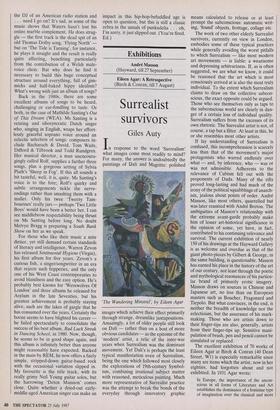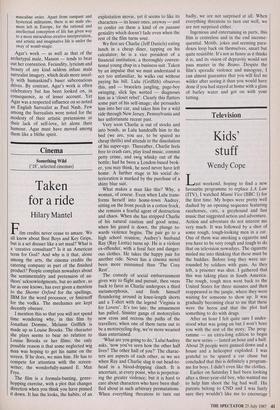Exhibitions
Andre Masson (Hayward, till 27 September) Eileen Agar: A Retrospective (Birch & Conran, till 7 August)
Surrealist survivors
Giles Auty
In response to the word 'Surrealism' what images come most readily to mind? For many, the answer is undoubtedly the paintings of Dali and Magritte: polished The Wandering Minstrel', by Eileen Agar images which achieve their effect primarily through strange, dreamlike juxtapositions. Amazingly, a lot of older people still look on Dali — rather than on a host of more obvious candidates — as the epitome of the `modern' artist, a relic of the inter-war years when Surrealism was the dominant movement. Yet Dali's is perhaps the least typical manifestation even of Surrealism, being the one which followed most closely the explorations of 19th-century Symbol- ism, combining irrational subject matter with reasoned, meticulous painting. Much more representative of Surrealist practice was the attempt to break the bonds of the everyday through innovatory graphic means calculated to release or at least prompt the subconscious: automatic writ- ing, 'found' objects, frottage, collage etc.
The work of two other elderly Surrealist survivors, currently on view in London, embodies some of these typical practices while generally avoiding the worst pitfalls to which Surrealism — like most modern art movements — is liable: a wearisome and depressing arbitrariness. If, as is often suggested, we are what we know, it could be reasoned that the art which is most consciously arrived at is also the most truly individual. To the extent which Surrealism claims to draw on the collective subcon- scious, the exact opposite could be argued. Those who see themselves only as taps to the subconscious world are clearly in dan- ger of a certain loss of individual quality. Surrealism suffers from the excesses of its own rhetoric. The Surrealist artist is not, of course, a tap but a filter. At least in this, he or she resembles most other artists.
If lay understanding of Surrealism is confused, this incomprehension is scarcely less than that of the movement's major protagonists who warred endlessly over what — and, by inference, who — was or was not admissible. Adherents to the relevance of Cubism fell out with the proponents of Dada. Many of the rifts proved long-lasting and had much of the irony of the political squabblings of anarch- ists, jealous about points of order. Andre Masson, like most others, quarrelled but was later reunited with Andre Breton. The ambiguities of Masson's relationship with the extreme avant-garde probably make him of lesser art-historical significance in the opinion of some, yet have, in fact, contributed to his continuing relevance and survival. The current exhibition of nearly 150 of his drawings at the Hayward Gallery is as welcome and overdue as that of the giant photo-pieces by Gilbert & George, in the same building, is questionable. Masson has earned his place in the history of the art of our century, not least through the poetic and mythological resonances of his particu- lar brand of primarily erotic imagery. Masson draws on sources in Chinese and Japanese art, no less than on European masters such as Boucher, Fragonard and Tiepolo. But what convinces, in the end, is neither the breadth of knowledge nor the eclecticism, but the assurance of his mark- making. Those who are artists down to their finger-tips are also, generally, artists from their finger-tips up. Sensitive mani- pulation of brush, pen and pencil cannot be simulated or replaced.
The excellent exhibition of 70 works of Eileen Agar at Birch & Conran (40 Dean Street, W1) is especially remarkable since many are items which the artist, now in her eighties, had forgotten about and not exhibited. In 1931 Agar wrote:
In Europe, the importance of the uncon- scious in all forms of Literature and Art establishes the dominance of a feminine type of imagination over the classical and more masculine order. Apart from rampant and hysterical militarism, there is no male ele- ment left in Europe, for the rational and intellectual conception of life has given way to a more miraculous creative interpretation, and artistic and imaginative life is under the sway of womb-magic.
Agar's work — as well as that of the archetypal male, Masson — tends to bear out her contention. Fecundity, lyricism and beauty of any kind seldom infuse male surrealist imagery, which deals more usual- ly with humankind's baser subconscious drives. By contrast, Agar's work is often celebratory but has been looked on, in Consequence, as of lesser account. Yet Agar was a respected influence on so noted an English Surrealist as Paul Nash. Few among the Surrealists were noted for the modesty of their artistic pretensions or their lack of self-love, let alone their humour. Agar must have moved among them like a blithe spirit.



















































 Previous page
Previous page